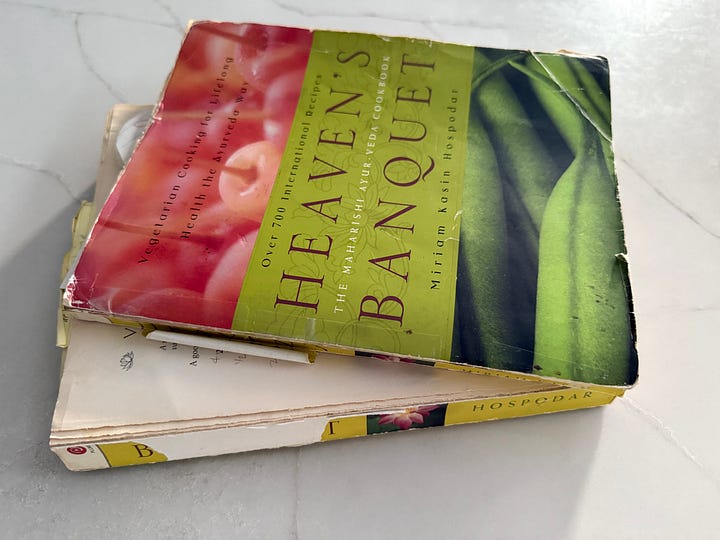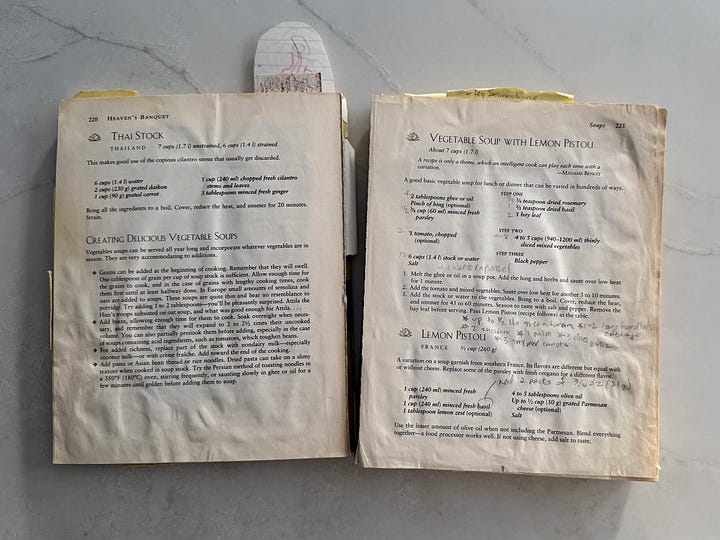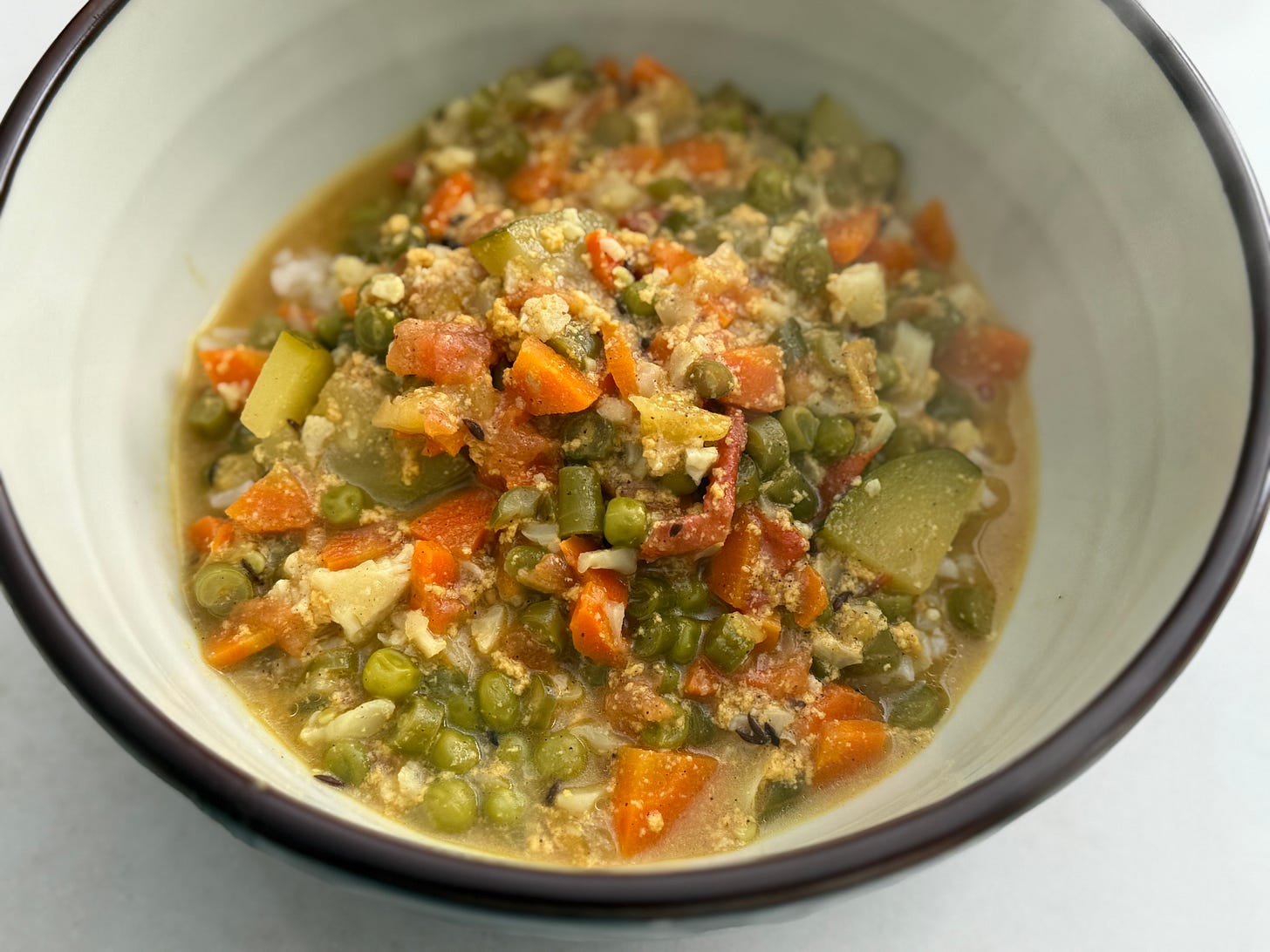To eat is human, to digest divine
A quiet rebellion in the kitchen, with Mixed Vegetable Curry II + Baked Rice
Don’t talk when chewing.
—Your Mother
(in Guidelines for Optimum Digestion, Heaven’s Banquet by Miriam Kasin Hospodar)
I wasn’t great at understanding recipes. Words like roast, braise, fold, mince — they were a different language to me. Also, I was not into cooking. Between the two, recipes felt impossible.
Then two miracles came along—
Patti G, an Ayurvedic chef, taught me how to love the process: light a beeswax candle, say a blessing, turn on sacred music, lay out the ingredients, admire their beauty; don’t just wash the veggies — massage them, even tickle them; mise en place (“everything in its place,” meaning prep and organize all ingredients and equipment before cooking). In sum: presence first.
And also, she gave me permission to enjoy whipped cream. I needed that permission back then.Miriam Kasin Hospodar. I never met her in person, but I reached out for permission to share the recipes below. She’s the author of Heaven’s Banquet: Vegetarian Cooking for Lifelong Health the Ayurveda Way. She drew her recipes from the international flavors she picked up in her travels and made them Ayurvedically sound. Her book is the reason recipes began to make sense to me. Thank you, Miriam! I owe you a debt of gratitude.
My other recipe books look almost new. Hers? Take a look—


I’ve never seen a book laid out the way she lays it out. First, she puts you in a state (similar to the way Patti would) with her words. She drops powerful quotes and offers essentials such as Guidelines for Optimum Digestion — so simple, extraordinary, and thought-provoking, like:
sit quietly for a few minutes after your meals
followed by a quote to bring it together:
To eat is human, to digest divine. — Charles T. Copeland.
I found her book in 2004. It was published in 1999. Especially back then, this kind of talk was what mainstream might call “radical.” Today, many who embrace it call it a quiet rebellion. I call it simple wisdom.
This section, Guidelines for Optimum Digestion, begins with a quote I think about to this day:
The fate of the nation has often depended upon the good or bad digestion of a prime minister. — Voltaire
If that’s true for nations, it’s true for a single household. And for a single body. Is it not?
The recipes are simple to follow, delicious, and come with backstories to help you understand the WHYs. Her words deliver presence. This book was a 23-year journey for Miriam, and you can feel that depth of love and commitment all the way through.
I need NEED to share with you my favorite: Mixed Vegetable Curry II.
I’ve made this for many potlucks and shared this in my own classes as a food meditation. I also share with you her ghee-kissed Baked Rice recipe that pairs well with this curry. Once you bake it, you may never go back to plain rice.
I’ll go straight into it now, leading with an excerpt on Indian-style veggies and curries that precedes this recipe from Miriam’s soul-steadying Heaven’s Banquet cookbook:
The spices and seasonings associated with Indian cooking are essential elements of Ayurvedic cooking. Your entire mind-body system sings a joyful song when it is offered vegetables sumptuously flavored with aromatic spices. Spices help ensure that the six tastes are present and accounted for, and individual spices offer many different health-enhancing effects.
Get the physical book, it’s so worth it.
HEADS UP: ingredients are grouped by step so you can move without backtracking. You’ll notice in the Baked Rice recipe that there isn’t a STEP ONE in the ingredients list. I did not inadvertently leave it out; there aren’t ingredients to work with in step one, so the list begins with STEP TWO.
Cooking like a blessing, not a chore
The recipe: Mixed Vegetable Curry II
INDIA, 4 servings
This is a buttermilk-based curry that coats tender vegetables in warm spice. Serve over rice or with flatbreads. Shared with permission from Miriam Kasin Hospodar.
STEP ONE
⅓ cup (75 g) ghee
½ teaspoon salt
1 teaspoon cumin seeds
½ teaspoon ground fenugreek
½ teaspoon ground cinnamon
¼ teaspoon ground cardamom
1 to 3 whole cloves
½ teaspoon turmeric
2 medium tomatoes, chopped
STEP TWO
2 tablespoons besan (chickpea flour)
2 cups (480 ml) buttermilk
STEP THREE
¾ cup each:
peas (110 g)
finely cut cauliflower (75 g)
zucchini, quartered lengthwise and sliced (75 g)
thinly sliced carrots (90 g)
finely cut green beans (85 g)
chopped fresh cilantro
Heat the ghee in a pot over low heat. Add the salt. Add the spices in order at 30-second intervals. When all the spices have been added, add the tomatoes and cook for 2 to 3 minutes. Mash with a fork while cooking.
Stir in the besan. Cook for 1 minute, stirring constantly. Slowly add the buttermilk, stirring constantly.
Add the vegetables. Cover and simmer until the vegetables are tender, about 30 minutes. Stir in the cilantro and adjust the salt.
VARIATION
Replace the buttermilk with coconut milk for a more cooling influence for pitta.
My notes:
I started using coconut milk while I was plant-based for 2.5 years. It’s just as good if not better.
This recipe is a true mindfulness meditation piece. Do not try to rush this, it will show in the outcome. Expect the prep work to take around 45 minutes. Light your beeswax candle, turn on your mantra or spa music (I love Deva Premal for this), take a few breaths to begin, and enjoy your practice.
The recipe: Baked Rice
4 to 6 servings
This is a triumph of technique. This simple method transforms simple ingredients into fragrant, separate grains with a gentle chew. Shared with permission from Miriam Kasin Hospodar.
STEP TWO
¼ cup (55 g) ghee
1 cup (205 g) long-grain white rice, preferably basmati
STEP THREE
2 cups (480 ml) water or 2 ¼ cups (540 ml) for basmati
½ teaspoon salt
Preheat the oven to 375°F (190°C). Butter a covered 1-quart baking dish.
Melt the ghee or butter in a saucepan. Add the rice and sauté over low heat for 1 to 2 minutes, stirring constantly.
Add the water and salt. Bring to a boil. Pour mixture into the baking dish.
Cover and bake until the liquid is absorbed, 20 to 30 minutes.
VARIATION
Stir in sautéed vegetables or chopped fresh herbs before baking.
Remember to eat in stillness for two minutes after the last bite. Notice how your body answers back.
And I shall close the way Miriam begins:
Let us be together,
Let us eat together,
Let us be vital together,
Let us be radiating truth, radiating the light of life,
Never shall we denounce anyone, never entertain negativity.
—THE UPANISHADS
Flow into the Upanishads, and then your gratitude list.
In gratitude for Miriam Kasin Hospodar, Patti G, Dr. Prabha Vaidya, Dr. Jerry Gore, Dr. John Peterson, and you for taking this journey with me,
– Savitree
Your Guide to Food as Medicine: I’m here to help you unlock your natural vitality through the power of food and mindful living.
If you want to practice food as medicine in your everyday kitchen, start with my 5-Day Digestion & Energy Reset. It’s free, and it includes 7 days of email support so you aren’t cooking alone. To start, subscribe now.
Ready for a steadier rhythm, recipes, and guidance that fit your life, not the other way around? Explore my Ayurvedic Keto Meal Plan. There’s a limited time discount already applied at checkout.





